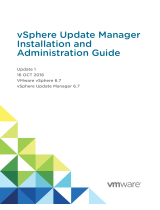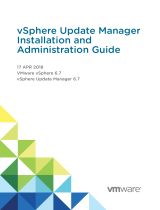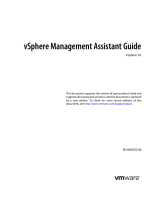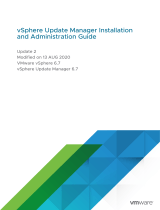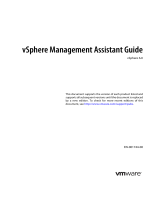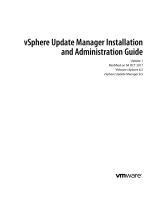Page is loading ...

Dell EMC Configuration and Deployment Guide
Configuring and Installing the PS Series
Multipathing Extension Module for VMware
vSphere and PS Series
Abstract
This document describes the benefits of the Dell™ PS Series
Multipathing Extension Module (MEM) for VMware
®
vSphere
®
that
provides MPIO for highly available access to the PS Series SAN.
November 2019

Revisions
2 Configuring and Installing the PS Series Multipathing Extension Module for VMware vSphere and PS Series | TR1074
Revisions
Date
Description
November 2011
Initial release
February 2012
General availability updates
September 2012
Updated Storage Heartbeat recommendation for vSphere 5.1
September 2013
Updated to reflect firmware 6.0 and vSphere 5.5
June 2015
Updated to include Virtual Volume support
July 2017
Updated to include web client UI changes to vSphere Update Manager, and MEM 1.5
November 2019
vVols branding update
The information in this publication is provided “as is.” Dell Inc. makes no representations or warranties of any kind with respect to the information in this
publication, and specifically disclaims implied warranties of merchantability or fitness for a particular purpose.
Use, copying, and distribution of any software described in this publication requires an applicable software license.
© 2011–2019 Dell Inc. or its subsidiaries. All Rights Reserved. Dell, EMC, Dell EMC and other trademarks are trademarks of Dell Inc. or its subsidiaries.
Other trademarks may be trademarks of their respective owners.
Dell believes the information in this document is accurate as of its publication date. The information is subject to change without notice.

Table of contents
3 Configuring and Installing the PS Series Multipathing Extension Module for VMware vSphere and PS Series | TR1074
Table of contents
Revisions............................................................................................................................................................................. 2
Acknowledgements ............................................................................................................ Error! Bookmark not defined.
Table of contents ................................................................................................................................................................ 3
Executive summary ............................................................................................................................................................. 4
1 Introduction ................................................................................................................................................................... 5
1.1 Audience ............................................................................................................................................................. 5
2 Deploying the MEM ...................................................................................................................................................... 6
2.1 Deployment considerations and requirements ................................................................................................... 6
2.2 Deployment considerations for iSCSI connection count .................................................................................... 6
2.3 Deployment considerations for iSCSI login timeout ........................................................................................... 8
2.4 Deployment considerations and best practice parameters ................................................................................ 8
3 Configuring an iSCSI vSwitch for multipathing ............................................................................................................. 9
3.1 Interactive mode configuration ........................................................................................................................... 9
3.2 Unattended mode configuration ....................................................................................................................... 11
4 Installing the MEM ...................................................................................................................................................... 12
5 Verification of MEM iSCSI session creation ............................................................................................................... 13
6 Advanced iSCSI connection configuration parameters .............................................................................................. 15
6.1 Increasing the default values ............................................................................................................................ 15
6.2 Decreasing the default values .......................................................................................................................... 16
6.3 Setting the EHCM configuration values under vSphere ................................................................................... 16
7 Using MEM with Virtual Volumes ............................................................................................................................... 18
7.1 MEM configuration and installation................................................................................................................... 18
7.2 Access controls................................................................................................................................................. 18
7.3 Virtual Volumes impact on iSCSI connection count ......................................................................................... 18
8 Summary .................................................................................................................................................................... 19
A Example iSCSI vSwitch configurations ...................................................................................................................... 20
B Installing the MEM with VMware Update Manager .................................................................................................... 21
C Using the setup.pl script to configure Round Robin MPIO ......................................................................................... 24
D Software and firmware versions ................................................................................................................................. 25
E Technical support and resources ............................................................................................................................... 26

Executive summary
4 Configuring and Installing the PS Series Multipathing Extension Module for VMware vSphere and PS Series | TR1074
Executive summary
Dell™ PS Series arrays optimize resources by automating performance and network load balancing. They
also offer all-inclusive array management software, host software, and free firmware updates.
High availability is an important requirement of any system in the data center. This availability is especially
critical if that system is a component in the virtual infrastructure where a virtualized datacenter is built.
Redundant hardware and RAID technologies form a critical foundation. When using shared storage, the paths
from the servers to the storage need to also be redundant and highly available.
This paper details the benefits of the Dell Multipathing Extension Module (MEM) for VMware
®
vSphere
®
, as
well as the installation and configuration process to provide Multi-Path I/O (MPIO) for high available access to
PS Series storage. Also covered are a number of overall virtual environment iSCSI design considerations and
best practices.

Introduction
5 Configuring and Installing the PS Series Multipathing Extension Module for VMware vSphere and PS Series | TR1074
1 Introduction
VMware vSphere offers many enhancements to the software iSCSI initiator beyond basic iSCSI SAN
connectivity. The most significant of these enhancements is the API support for third-party multipathing
plugins. This provides a framework that enables the MEM to intelligently route and efficiently load balance
iSCSI traffic across multiple NICs.
The MEM provides the following benefits:
• Ease of installation
• Increased bandwidth
• Reduced network latency
• Automatic failure detection and failover
• Automatic load balancing across multiple active paths
• Automatic connection management
• Multiple connections to a single iSCSI target
The MEM utilizes the same multipathing iSCSI vSwitch as VMware Round Robin multipathing. As part of the
continuous efforts at Dell to help customers simplify the configuration of their IT environments, the iSCSI
MPIO vSwitch configuration process for the MEM has been reduced to either a single command with a few
parameters or a guided question-and-answer process. The MEM installation process is equally
straightforward, requiring that only a single command be executed. The MEM can also be installed using the
VMware vSphere Update Manager.
Once installed, the MEM automatically creates iSCSI sessions to each member that a volume spans. As the
storage environment changes, the MEM responds by automatically adding or removing needed iSCSI
sessions.
As storage I/O requests are generated on the VMware ESXi™ hosts, the MEM intelligently routes each
requests to the appropriate array member. This results in efficient load balancing of the iSCSI storage traffic,
reduced network latency and increased bandwidth.
1.1 Audience
The information in this guide is intended for administrators of a VMware vSphere environment utilizing PS
Series iSCSI arrays.

Deploying the MEM
6 Configuring and Installing the PS Series Multipathing Extension Module for VMware vSphere and PS Series | TR1074
2 Deploying the MEM
Deploying the MEM consists of two steps:
1. Configuring a vSwitch for iSCSI multipathing
2. Installing the MEM
The entire process of creating the multipathing-compatible vSwitch and installing the MEM is quick and
efficient. Once deployed, it provides both new and existing ESXi hosts with increased performance to PS
Series storage resources.
2.1 Deployment considerations and requirements
The MEM has the following requirements:
• VMware vSphere ESXi with Standard licensing (see Table 1)
• vSphere Command-Line Interface (CLI) or vSphere Management Assistant (vMA) compatible with
above version of ESXi
• Compatible PS Series array firmware (refer to the release notes on eqlsupport.dell.com — login
required)
Prior to deploying the MEM, complete the following steps:
1. Place the ESXi host(s) in maintenance mode.
2. Download and install either the VMware vMA or vSphere CLI. Refer to VMware Documentation to
install and configure these tools.
3. Download the EqualLogic Multipathing Extension Module for VMware from eqlsupport.dell.com (login
required). The download is a zip archive named EqualLogic-ESX-Multipathing-Module.zip.
4. Unpack the zip archive files:
- MEM-Release_Notes.pdf
- MEM-User_Guide.pdf
- README.txt
- setup.pl
- dell-eql-mem-esx<vSphere_version>-<release version>.zip
Note: Do not extract dell-eql-mem-esx<vSphere_version>-<release version>.zip. It is a vSphere Installation
Bundle (VIB) offline bundle.
5. If using the vMA, upload setup.pl and the VIB offline bundle to the vMA.
6. Retain the MEM-Release_Notes.pdf, MEM-User_Guide.pdf (EqualLogic Multipathing Extension
Module Installation and User Guide), and README.txt files for reference.
2.2 Deployment considerations for iSCSI connection count
The MEM provides increased bandwidth and lower latency access to PS Series storage. This performance
benefit is achieved through leveraging several behaviors that are unique to the PS Series peer storage
architecture. It is important to understand how MEM achieves performance gains, and the potential impact on
storage if it is not deployed.

Deploying the MEM
7 Configuring and Installing the PS Series Multipathing Extension Module for VMware vSphere and PS Series | TR1074
The MEM achieves its performance gains by creating multiple iSCSI connections to each PS Series group
member that has a datastore volume. Assuming the MEM default settings are in use, and depending on the
configuration of the environment, there will be up to six iSCSI connections to a datastore volume. This is a
significant increase, when compared with the VMware Fixed path policy, which utilizes one iSCSI connection
per volume. This increase in connections must be planned at the time of deployment, and again as the
vSphere environment and its supporting PS Series storage environment scales.
To calculate the number of iSCSI connections that the MEM will consume in a particular environment, utilize
the following formula:
𝑁𝑢𝑚𝑏𝑒𝑟 𝑜𝑓 𝑖𝑆𝐶𝑆𝐼 𝑐𝑜𝑛𝑛𝑒𝑐𝑡𝑖𝑜𝑛𝑠 = 𝐻 × 𝑉 × 𝑀 × 2
H = number of ESXi hosts
V = number of volumes
M = number of PS Series members in the pool (maximum value is 3)
2 = default number of iSCSI sessions per volume portion
For example, in a vSphere environment with eight ESXi hosts, and using a two-member PS Series pool for
hosting the ten volumes needed for virtual machines, the number of iSCSI connections would be:
8 x 10 x 2 x 2 = 320 iSCSI connections
While this is within the 1,024 iSCSI connection limit per pool of the firmware, it does not take into account
other iSCSI connections to the PS Series storage pool from other servers in the data center. Consider how
this virtual environment may grow in the future with respect to additional ESXi hosts, datastore volumes, and
additional PS Series members.
Using the SCSI commands, MEM and the array can communicate certain information. This enables the array
to notify the MEM of the number of total iSCSI connections to the pool from all sources. Should the number of
iSCSI connections to the pool begin to approach the limit, the MEM will reduce the number of iSCSI sessions
it is creating to the array, while still maintaining redundancy.
Depending on the overall environment and future requirements, changes may need to be made to one or
more of the following variables if there are concerns about the iSCSI connection count growing too large:
• The MEM parameters membersessions, volumessessions or totalsessions (see the
EqualLogic Multipathing Extension Module Installation and User Guide for details).
• Increasing the size of a given volume to allow more virtual machines to reside on it and reduce the
total number of volumes needed.
• Reconfigure larger clusters into multiple smaller clusters to reduce the number of hosts accessing
particular volumes and the number of iSCSI connections consumed.
• Reduce the number of PS Series members per pool and increase the number of pools to increase the
number of available iSCSI connections.
For more information on this topic, read the document, Dell Storage PS Series Arrays: Scalability and Growth
in Virtual Environments.
The MEM iSCSI connection algorithm works to avoid creating unnecessary sessions while still maintaining
redundancy. The Dell PS6110, PS4110, and PS-M4110 arrays have only one 10Gb Ethernet port and
therefore fewer iSCSI connections are created compared to arrays with multiple Ethernet ports per controller.
With the PS6110, PS4110, and PS-M4110 arrays in a single-member pool, MEM creates two iSCSI
connections per volume, for redundancy. In a two- or three-member pool, MEM creates a single iSCSI

Deploying the MEM
8 Configuring and Installing the PS Series Multipathing Extension Module for VMware vSphere and PS Series | TR1074
connection per member, resulting in creating two or three iSCSI connections per volume. This balances the
bandwidth and throughput from an individual ESXi host with that of an individual PS Series member.
Note: The vSphere 6.0 feature Virtual Volumes changes the way the iSCSI connections are made between
the host and the volumes. See section 7, Using MEM with Virtual Volumes, for details.
2.3 Deployment considerations for iSCSI login timeout
The default value of 5 seconds for iSCSI logins on vSphere ESXi is too short in some circumstances, such as
a large configuration where the number of iSCSI sessions to the array is close to the limit of 1024 per pool. If
a severe network disruption were to occur, such as the loss of a network switch, a large number of iSCSI
sessions need to be reestablished. With such a large number of logins occurring, completely processing the
logins takes longer than the five-second default timeout period. The MEM installer automatically sets the
iSCSI Login Timeout to the value of 60 seconds as recommended by Dell EMC.
The iSCSI Login Timeout value can be set using esxcli with the following syntax:
esxcli iscsi adapter param set --adapter=vmhba --key=LoginTimeout --value=60
Note: By default, the MEM setup.pl will attempt to update this value at configuration time.
2.4 Deployment considerations and best practice parameters
The MEM setup.pl script for configuring the ESXi host iSCSI vSwitch can be pass the --bestpractice
parameter, which enables the following best practices:
Disabling Delayed ACK: Delayed ACK is a TCP/IP method of reducing I/O overhead by allowing segment
acknowledgements to piggyback on each other or on other data passed over a connection. One side effect of
delayed ACK is that if the pipeline is not filled, acknowledgement of data is delayed. In SAN Headquarters
(SANHQ), this can be seen as higher latency during lower I/O periods. Latency is measured from the time the
data is sent to when the acknowledgement is received. Since we are talking about disk I/O, any increase in
latency can result in poorer performance. Additional information can be found in VMware Knowledge Base
article 1002598.
Disabling Large Receive Offload: Similar to Delayed ACK, Large Receive Offload (LRO) works by
aggregating packets into a buffer before the received data is sent to the TCP stack. With iSCSI storage, this
additional latency inserted into the process could potentially reduce performance for some workloads.
Additional information can be found in VMware Knowledge Base article 2055140.
Note: While iSCSI login timeout is considered a best practice, it is also consider a requirement, and therefore
is always set to 60 seconds during configuration.

Configuring an iSCSI vSwitch for multipathing
9 Configuring and Installing the PS Series Multipathing Extension Module for VMware vSphere and PS Series | TR1074
3 Configuring an iSCSI vSwitch for multipathing
The MEM utilizes the same multipathing vSwitch as the VMware native Round Robin multipathing. Therefore,
if the ESXi hosts are already configured for Round Robin, this step can be omitted. However, if the ESXi
hosts are configured for Fixed Path, remove the iSCSI initiator and associated vSwitch before continuing. The
MEM setup.pl script provides powerful functionality and is easy to use compared to the manual configuration
process.
Note: The instructions provided here refer to using the vMA, however, the syntax is the same whether the
vMA or CLI is used. The optional parameters --username and --password have been excluded from the
examples below for clarity. If not included and vi-fastpass is not configured, the user will be prompted to
provide the username and password.
1. Connect to the vMA and change the directory to where the setup.pl was uploaded.
2. Create a multipathing iSCSI vSwitch by invoking the setup.pl in interactive mode.
setup.pl --configure --server=hostname
3.1 Interactive mode configuration
In this configuration mode, a series of questions are posed to the user, and default options presented when
available. To accept a default, press [Enter].
Note: The following example was generated using MEM 1.3 and vSphere 6.0, the output may differ slightly
with other combinations.
setup.pl --configure --server=10.124.6.223
Do you wish to use a standard vSwitch or a vNetwork Distributed Switch
(vSwitch/vDS) [vSwitch]:
Found existing switches vSwitch0.
vSwitch Name [vSwitchISCSI]:
Which nics do you wish to use for iSCSI traffic? [vmnic1 vmnic2 vmnic3]: vmnic2
vmnic3
IP address for vmknic using nic vmnic2: 192.168.0.215
IP address for vmknic using nic vmnic3: 192.168.0.216
Netmask for all vmknics [255.255.255.0]:
What MTU do you wish to use for iSCSI vSwitches and vmknics? Before increasing
the MTU, verify the setting is supported by your NICs and network switches.
[1500]: 9000
What prefix should be used when creating VMKernel Portgroups? [iSCSI]:
The SW iSCSI initiator is not enabled, do you wish to enable it? [yes]:
What PS Group IP address would you like to add as a Send Target discovery
address (optional)?: 192.168.0.200
What CHAP user would you like to use to connect to volumes on this group
(optional)?: BLUEcluster
What CHAP secret would you like to use to connect to volumes on this group
(optional)?:
Configuring iSCSI networking with following settings:
Using a standard vSwitch 'vSwitchISCSI'

Configuring an iSCSI vSwitch for multipathing
10 Configuring and Installing the PS Series Multipathing Extension Module for VMware vSphere and PS Series | TR1074
Using NICs 'vmnic2,vmnic3'
Using IP addresses '192.168.0.215,192.168.0.216'
Using netmask '255.255.255.0'
Using MTU '9000'
Using prefix 'iSCSI' for VMKernel Portgroups
Using SW iSCSI initiator
Enabling SW iSCSI initiator
Adding PS Series Group IP '192.168.0.200' with CHAP user 'CHAPuser' to
Send Targets discovery list.
The following command line can be used to perform this configuration:
setup.pl --configure --server=10.124.6.223 --vswitch=vSwitchISCSI --mtu=9000 --
nics=vmnic2,vmnic3 --ips=192.168.0.215,192.168.0.216 --netmask=255.255.255.0 --
vmkernel=iSCSI --nohwiscsi --enableswiscsi --groupip=192.168.0.200 --
chapuser=BLUEcluster
Do you wish to proceed with configuration? [yes]:
Note: The CHAP secret is not displayed as part of the command line that Interactive Mode generates.
As the script executes, it provides status notifications through several steps while creating the multipathing
iSCSI vSwitch. Once complete, a multipathing iSCSI vSwitch will be created on the ESXi host, as shown in
Figure 1.
Multipathing iSCSI vSwitch created using MEM setup.pl script
A detailed list of all the parameters, options, and usage is provided in the EqualLogic Multipathing Extension
Module Installation and User Guide. Additional configuration examples are provided in appendix A.

Configuring an iSCSI vSwitch for multipathing
11 Configuring and Installing the PS Series Multipathing Extension Module for VMware vSphere and PS Series | TR1074
3.2 Unattended mode configuration
While setup.pl scripts interactive mode is extremely helpful, using it to configure all the hosts in a cluster is not
efficient. Instead, passing the values of the various parameters to the setup.pl script provides a more efficient
means of configuring several hosts.
At the end of the interactive mode configuration, the resulting command-line questions and answers are
presented as shown in the example below.
setup.pl --configure --server=10.124.6.223 --vswitch=vSwitchISCSI
--mtu=9000 --nics=vmnic2,vmnic3 --ips=192.168.0.215,192.168.0.216
--netmask=255.255.255.0 --vmkernel=iSCSI
--nohwiscsi --enableswiscsi --groupip=192.168.0.200
--chapuser=BLUEcluster
Using this as an example, modify the hostname and IP information to provision additional ESXi hosts with the
same vSwitch configuration.
setup.pl --configure --server=10.124.6.224 --vswitch=vSwitchISCSI
--mtu=9000 --nics=vmnic2,vmnic3 --ips=192.168.0.225,192.168.0.226
--netmask=255.255.255.0 --vmkernel=iSCSI
--nohwiscsi --enableswiscsi --groupip=192.168.0.200
--chapuser=BLUEcluster --chapsecret=BLUEsecret
Note: The CHAP secret is not displayed as part of the generated interactive mode command line, but was
added to the example above. If it is not included, setup.pl will prompt for the CHAP secret at run time, if a
CHAP user is specified.
Depending on the required configuration of the multipathing iSCSI vSwitch, additional parameters may be
required or removed. For a full list of parameters and their defaults, see “Configuring Your Network for the
MEM Plugin” in the EqualLogic Multipathing Extension Module Installation and User Guide.

Installing the MEM
12 Configuring and Installing the PS Series Multipathing Extension Module for VMware vSphere and PS Series | TR1074
4 Installing the MEM
The MEM can be installed using the command-line tools (CLI or vMA) or with vSphere Update Manager
(VUM). The command-line tools are used in the example in this section. See appendix B for installation
instructions using VUM.
Setup.pl is a Perl script wrapper around a number of VMware CLI commands. It provides administrators with
a similar installation process, regardless of the vSphere version.
Note: Prior to installation, setup.pl copies the VIB to the first datastore it finds if a particular datastore has not
been specified using the --datastore parameter. Due to API limitations, the VIB is not deleted by setup.pl.
Note: When performing an upgrade or uninstall of the MEM, a reboot is required on all versions of vSphere.
1. Using the vMA or vSphere CLI, install the MEM on each host with the command:
setup.pl --install --server=hostname
It may take a few minutes to install the module to the ESXi host.
2. Reboot the ESXi host to enable the plugin multipathing functionality. This may be done manually
during the host configuration process or automatically after the MEM module is installed by
appending the –-reboot parameter to the above command line.
3. To verify the availability of the MEM, execute the command:
setup.pl --query --server=hostname
As shown in the following, running this command displays the presence and status of the MEM on the
host and any volumes it is the active PSP for.
Found Dell EqualLogic Multipathing Extension Module installed: 1.5.0
Default PSP for EqualLogic devices is DELL_PSP_EQL_ROUTED.
Active PSP for naa.6090a088f03eebc07ee924f465696412 is
DELL_PSP_EQL_ROUTED.

Verification of MEM iSCSI session creation
13 Configuring and Installing the PS Series Multipathing Extension Module for VMware vSphere and PS Series | TR1074
5 Verification of MEM iSCSI session creation
By default, the MEM claims existing and new PS Series volumes and then creates the additional iSCSI
session used by the MEM to route the iSCSI data. To verify these additional sessions, perform the following
steps:
1. From the vSphere Web Client, click the storage icon, and on the vCenter object pane on the left,
select a datastore.
2. For that datastore, select the Manage tab, and click Settings.
3. Select an individual host from the cluster where the datastore is mounted, and expand the paths.
Notice that the Path Selection Policy is set to DELL_PSP_EQL_ROUTED, and that there are multiple paths
with active I/O to the target volume backing the datastore.

Verification of MEM iSCSI session creation
14 Configuring and Installing the PS Series Multipathing Extension Module for VMware vSphere and PS Series | TR1074
This can also be verified from the array web GUI on the Connections tab of the volume. The following
example shows two iSCSI sessions have been established from each of the VMkernel ports on the ESXi host
to the volume.

Advanced iSCSI connection configuration parameters
15 Configuring and Installing the PS Series Multipathing Extension Module for VMware vSphere and PS Series | TR1074
6 Advanced iSCSI connection configuration parameters
The few configuration parameters that are needed with the MEM are used to alter the runtime behavior of the
EqualLogic Host Connection Manager (EHCM) that manages the iSCSI sessions to the PS Series volumes.
For information on all of the parameters, refer to the EqualLogic Multipathing Extension Module Installation
and User Guide.
Three configuration parameters affect the number of iSCSI sessions created:
• totalsessions: The maximum total number of sessions that may be created on all PS Series volumes
accessible to the host. The default value is 512.
• volumesessions: The maximum number of sessions that may be created on an individual PS Series
volume. The default value is 6.
• membersessions: The maximum number of session that may be created on the portion of a volume
that resides on a single member. The default value is 2.
When determining how many sessions to create, EHCM chooses a value that meets all these constraints.
The default values provide good performance without unnecessarily consuming excess resources. In the
majority of installations, these settings do not need to be changed from the defaults.
Prior to altering these values, it is strongly advised that an administrator fully understand the impact of such a
change on the total number of iSCSI connections. For information on the number of iSCSI connections that
particular firmware versions can handle at a per pool and group level, refer to the release notes for that
firmware. Refer to the applicable VMware documentation for details on vSphere limits that may apply.
Section 2.2, Deployment considerations for iSCSI connection count, includes a formula for calculating the
iSCSI connection count based on the number of hosts, sessions per volume portion, PS Series members in
the pool, and the number of volumes the hosts are connected to. Take into account connections from other
systems in the total iSCSI connection count such as:
• Other physical servers
• Virtual machines with iSCSI within the guest connections
• Backup servers
• Short-lived connections which are used by the vSphere VAAI Full Copy primitive and replication
6.1 Increasing the default values
In some lab settings, it may be necessary to increase the number of iSCSI connections for benchmarking I/O
to an individual volume or to test the limits.
In such a configuration, it is possible that the default membersession value is limiting the number of iSCSI
connections to fewer than the number of VMkernel ports bound to the iSCSI initiator. To utilize all the
VMkernel ports bound to the iSCSI initiator, increase membersessions sufficiently to enable EHCM to create
iSCSI connections through all bound VMkernel ports.
Generally, this increase would not be beneficial in a production environment. In a production environment,
multiple volumes are used, and EHCM would, in aggregate, create and balance an optimal number of iSCSI
sessions to effectively utilize all of the network ports.

Advanced iSCSI connection configuration parameters
16 Configuring and Installing the PS Series Multipathing Extension Module for VMware vSphere and PS Series | TR1074
6.2 Decreasing the default values
In large configurations, reduce the number of iSCSI connections if the limits of the array firmware are
exceeded. This can be achieved by:
• Reducing the number of volumes: By increasing the size of a given volume, more virtual machines
can reside on it, thereby reducing the total number of volumes needed.
• Reconfiguring larger clusters into multiple smaller clusters: By splitting a large cluster into smaller
clusters, the number of hosts accessing particular volumes is reduced, thereby reducing the number
of iSCSI connections consumed.
• Altering the configuration of the PS Series group: Reducing the number of PS Series members per
pool, and increasing the number of pools, will increase the number of available iSCSI connections.
These changes typically take some time to implement. Altering the EHCM parameters provides a means of
quickly reducing the iSCSI connection to be within limits. However, depending on the overall environment
configuration and I/O workload, a drop in overall performance may be observed.
• totalsessions: This parameter is defaulted to a maximum of 512, and can be lowered to 64. It is the
maximum number of iSCSI connections that EHCM will create from this individual ESXi host to all PS
Series arrays. If an additional volume is added to the host, EHCM automatically rebalances the
sessions to include the new and existing volumes, without consuming more than the totalsessions
limit.
• volumesessions: This parameter is defaulted to a maximum of 6, and can be lowered to 1. It is the
maximum number of iSCSI connections that EHCM will make from this individual ESXi host to each
individual PS Series volume, regardless of the number of array members the volume may span as the
group expands. This value applies to all volumes that the host accesses, and cannot be specified to
affect only particular volumes. As additional members are added to the pool, and volumes are
distributed to include this new member, EHCM creates additional sessions to the volume within this
limit.
• membersessions: This parameter is defaulted to a maximum of 2, and can be lowered to 1. It is the
number of iSCSI connections that EHCM makes from this individual ESXi host to the portion of a
volume that resides on an individual PS Series member. Setting membersessions to 1 will halve the
iSCSI connection count from the ESXi host to the array. However, this effectively disables the Least
Queue Depth part of the MPIO algorithm, as there is one queue to each portion of the volume. The
Intelligent Routing part of the algorithm remains in use, so I/O requests will be efficiently directed to
the appropriate member.
Note: Similar default values for VMware
®
vSphere
®
Virtual Volumes™ (vVols) are defined in ehcmd.conf. See
the product documentation for details.
6.3 Setting the EHCM configuration values under vSphere
PS Series arrays have added a number of commands that can be used to control and report on the status of
the MEM. It is through these commands that the EHCM parameters are changed.
The esxcli command can be executed remotely from the vMA, CLI, or directly on the ESXi host. The syntax of
this command is:
esxcli equallogic param set --name=parameter_name
--value=parameter_value

Advanced iSCSI connection configuration parameters
17 Configuring and Installing the PS Series Multipathing Extension Module for VMware vSphere and PS Series | TR1074
For example:
esxcli equallogic param set --name=membersession --value=1
To query the current EHCM values, use the following syntax:
esxcli equallogic param list

Using MEM with Virtual Volumes
18 Configuring and Installing the PS Series Multipathing Extension Module for VMware vSphere and PS Series | TR1074
7 Using MEM with Virtual Volumes
VMware introduced the Virtual Volumes (vVols) feature with vSphere 6.0. It enables per-VM granularity for
many storage-related tasks, as opposed to per-volume granularity. While vVols do not require MEM, the
inclusion of MEM in a PS Series vVol environment provides more efficient routing of I/O, reduced latency, and
increased bandwidth utilization. For additional information on Virtual Volumes, see VMware vSphere Virtual
Volumes on Dell PS Series.
7.1 MEM configuration and installation
While vVol changes many things when it comes to architecting a vSphere environment, it does not alter the
creation of the iSCSI vSwitch for multipathing, or the installation process of the MEM.VIB.
7.2 Access controls
One aspect that has changed with vVols is access controls. With traditional volumes, access to a volume is
managed through an access control list or access control policy, on a per-volume basis. However, with vVols
volumes, this no longer applies. Access is restricted by an access control list on the protocol endpoint, and
managed from the PS Series Virtual Storage Manager (VSM) plugin for vCenter. For detailed instructions on
vVol access controls, see the document, Dell Virtual Storage Manager: Installation Considerations and Local
Data Protection.
7.3 Virtual Volumes impact on iSCSI connection count
With traditional VMFS datastores, the iSCSI connection terminated at the individual volume, but with vVols,
this has changed. The iSCSI connection now terminates at the protocol endpoint, resulting in a lowering of the
iSCSI connection count, regardless of the number of storage containers or the number vVol-based virtual
machines. With MEM and vVols, the iSCSI connection count is now simply one iSCSI connection per
VMkernel/PS Series member pair, with a minimum of at least two iSCSI connections from each host to the
ESXi host to the protocol endpoint. The formula can be expressed as:
Number of VMkernel ports used for iSCSI x Number of members in group x two sessions per member
For example, if there are three PS6210 arrays, and each host is configured with two VMkernel ports for iSCSI,
then six iSCSI connections will be created from each host.
As with all rules, there are exceptions. With the PS6110, PS4110, and PS-M4110 arrays, if they are in a
single-member pool, MEM will create two iSCSI connections to the protocol endpoint for redundancy. With
two or more such members in the pool, MEM will create a single iSCSI connection per member, resulting in
one iSCSI connection being created per member to the protocol endpoint.
When mixing traditional volumes and virtual volumes, the iSCSI connection pool limit applies to the combined
total of iSCSI connections from traditional volumes and the iSCSI connection to the protocol endpoint.

Summary
19 Configuring and Installing the PS Series Multipathing Extension Module for VMware vSphere and PS Series | TR1074
8 Summary
Through its intelligent routing and load balancing, the MEM can provide a reduction in network latency and an
increase in bandwidth to PS Series storage arrays. Through automated setup and host connection
management, the MEM also reduces the steps for deployment and ongoing management of advanced
vSphere iSCSI configurations.

Example iSCSI vSwitch configurations
20 Configuring and Installing the PS Series Multipathing Extension Module for VMware vSphere and PS Series | TR1074
A Example iSCSI vSwitch configurations
This appendix provides some examples of the additional parameters used with the setup.pl configuration
script. A detailed list of all the parameters and their usage can be found in the EqualLogic Multipathing
Extension Module Installation and User Guide.
A.1 Overriding hardware iSCSI offload default utilization
ESXi can utilize the iSCSI offload capabilities of the Broadcom
®
NetXtreme II network adapters, resulting in
significantly lower software iSCSI CPU utilization. By default, the setup.pl configuration script will utilize this
iSCSI offload capability if it is present. If there is a preference not to use the iSCSI offload capability, this must
be specified when configuring the iSCSI vSwitch. This is shown as follows:
setup.pl --configure --server=172.17.5.121 --nics=vmnic2,vmnic3
--ips=192.168.0.215,192.168.0.216 --nohwiscsi
A.2 Utilizing a vNetwork distributed switch
With Enterprise Plus licensing, VMware provides a virtual switch which spans many ESXi hosts. This
abstracts the configuration of individual vSwitches on the host level and enables centralized management
through vSphere vCenter server. If utilizing a vNetwork Distributed Switch for iSCSI traffic, the --vds
parameter must be specified. Should the name of the vNetwork Distributed Switch differ from the default
utilized by the configuration script, it can be specified using the –-vswitch parameter. This is shown as follows:
setup.pl --configure --server=172.17.5.121 --nics=vmnic2,vmnic3
--ips=192.168.0.215,192.168.0.216 –-vswitch vdsISCSI --vds
A.3 Enabling Jumbo Frames
With the vSphere release of ESXi support for Jumbo Frames has been extended to VMkernel traffic, which
includes the iSCSI stack. To utilize Jumbo Frames, they must be enabled on all networking components
used. By default, the setup.pl script uses an MTU of 1500 when creating the iSCSI vSwitch and VMkernel
interfaces. To use a larger value, specify it as demonstrated in the following example:
setup.pl --configure --server=172.17.5.121 --nics=vmnic2,vmnic3
--ips=192.168.0.215,192.168.0.216 –-mtu=9000
A.4 Setting the iSCSI discover address
It is possible to specify the group IP of an array to be set as the send targets discovery address for the iSCSI
initiator.
setup.pl --configure --server=172.17.5.121 --nics=vmnic2,vmnic3
--ips=192.168.0.215,192.168.0.216 –-groupip=192.168.0.200
/
